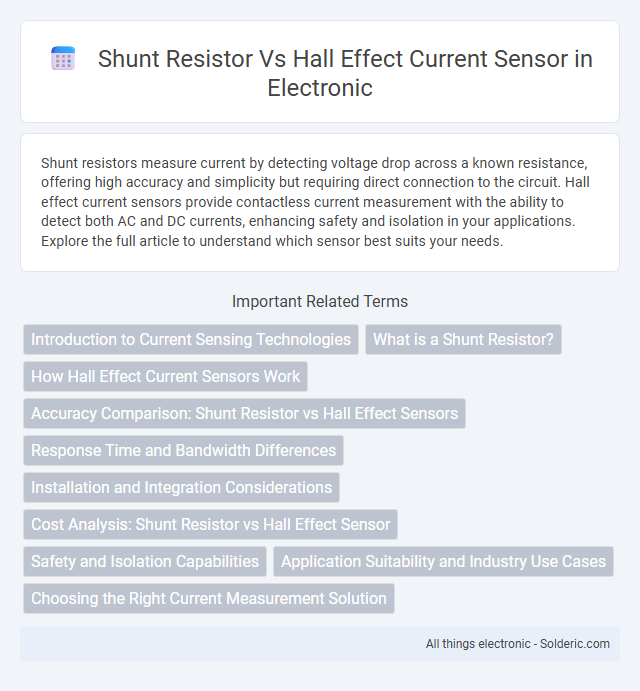Shunt resistors measure current by detecting voltage drop across a known resistance, offering high accuracy and simplicity but requiring direct connection to the circuit. Hall effect current sensors provide contactless current measurement with the ability to detect both AC and DC currents, enhancing safety and isolation in your applications. Explore the full article to understand which sensor best suits your needs.
Comparison Table
| Feature | Shunt Resistor | Hall Effect Current Sensor |
|---|---|---|
| Measurement Principle | Voltage drop across a low-value resistor | Magnetic field generated by current |
| Accuracy | High accuracy, typically +-0.5% to +-1% | Moderate accuracy, typically +-1% to +-3% |
| Isolation | No electrical isolation (direct connection) | Provides galvanic isolation |
| Power Dissipation | Higher power loss proportional to current | Low power loss, non-intrusive measurement |
| Measurement Range | Usually low to medium current ranges | Suitable for low to very high current ranges |
| Response Time | Fast response | Slower response due to sensor electronics |
| Size | Compact but needs high power resistor for high currents | Generally larger due to magnetic core and electronics |
| Cost | Low cost | Higher cost |
Introduction to Current Sensing Technologies
Shunt resistors measure current by detecting the voltage drop across a precise low-value resistor, offering high accuracy and simplicity for DC and low-frequency applications. Hall effect current sensors use magnetic fields to sense current without direct electrical contact, enabling isolation and measurement of AC, DC, and complex waveforms with minimal power loss. Both technologies serve distinct roles in current sensing, with shunt resistors favored for cost-effective, high-precision tasks and Hall effect sensors preferred for galvanic isolation and non-intrusive measurement.
What is a Shunt Resistor?
A shunt resistor is a precise, low-resistance component used to measure current by detecting the voltage drop across it, enabling accurate current sensing in electrical circuits. It operates on Ohm's law, where the measured voltage drop is proportional to the current flowing through the resistor. Unlike Hall effect current sensors that detect current magnetically, shunt resistors provide direct electrical measurement, making them ideal for high-accuracy and cost-sensitive applications.
How Hall Effect Current Sensors Work
Hall Effect Current Sensors operate by detecting the magnetic field generated by current flow through a conductor, utilizing a Hall element that produces a voltage proportional to the magnetic field strength. Unlike shunt resistors that measure voltage drop directly, Hall sensors provide galvanic isolation and minimal power loss while enabling contactless current measurement. These sensors are ideal for applications requiring high accuracy, electrical isolation, and real-time current monitoring in complex electrical systems.
Accuracy Comparison: Shunt Resistor vs Hall Effect Sensors
Shunt resistors provide high accuracy in current measurement due to their direct voltage drop measurement proportional to current, typically achieving accuracy levels within +-0.1%. Hall effect current sensors offer lower accuracy, generally around +-1%, because they measure magnetic fields induced by current flow, which can be affected by external magnetic interference and temperature variations. For precision-critical applications, shunt resistors are preferred, while Hall effect sensors are suitable for isolation and non-intrusive measurements despite modest accuracy trade-offs.
Response Time and Bandwidth Differences
Shunt resistors exhibit extremely fast response times and wide bandwidths, often reaching into the MHz range, making them ideal for high-frequency current measurements. Hall effect current sensors typically have slower response times, generally in the microsecond range, and bandwidths limited to a few hundred kHz due to their magnetic sensing principles. These characteristics determine their suitability for applications requiring either rapid transient detection or non-intrusive current sensing with isolation.
Installation and Integration Considerations
Shunt resistors require direct electrical connection in series with the load, demanding precise placement to minimize voltage drop and heat dissipation, which can complicate installation in tight spaces. Hall effect current sensors offer easier non-intrusive installation with galvanic isolation, allowing integration without breaking the circuit, making them suitable for applications where safety and circuit integrity are priorities. Your choice between the two depends on factors like installation environment, accuracy needs, and system isolation requirements.
Cost Analysis: Shunt Resistor vs Hall Effect Sensor
Shunt resistors offer a low-cost solution for current measurement with minimal component expense, making them ideal for budget-sensitive applications. Hall effect current sensors typically incur higher costs due to integrated magnetic components and advanced circuitry, but they provide galvanic isolation and reduced power loss. Evaluating total cost also requires considering factors such as installation complexity, accuracy requirements, and thermal management.
Safety and Isolation Capabilities
Shunt resistors measure current by detecting voltage drop, offering accurate readings but lacking inherent electrical isolation, which can pose safety risks in high-voltage applications. Hall effect current sensors provide galvanic isolation by using magnetic fields to measure current without direct electrical contact, enhancing user and equipment safety. Your choice should weigh shunt resistor efficiency against the superior isolation and protection offered by Hall effect sensors in sensitive or hazardous environments.
Application Suitability and Industry Use Cases
Shunt resistors excel in high-precision, low-cost current measurement applications such as power supplies, battery management systems, and automotive diagnostics, where direct current sensing and minimal signal conditioning are critical. Hall effect current sensors offer non-invasive, galvanically isolated current sensing suitable for industrial automation, electric vehicles, and renewable energy systems, where measuring AC or high-current DC without interrupting the circuit is essential. Your choice depends on application requirements like isolation, frequency response, accuracy, and environmental conditions in targeted industries.
Choosing the Right Current Measurement Solution
Choosing the right current measurement solution depends on factors like accuracy, cost, and application environment. Shunt resistors offer high accuracy and fast response for low to medium current ranges but cause power loss and heat dissipation. Hall effect current sensors provide galvanic isolation and can measure high currents with minimal power loss, making them ideal for your applications requiring non-intrusive measurements and electrical isolation.
shunt resistor vs hall effect current sensor Infographic

 solderic.com
solderic.com